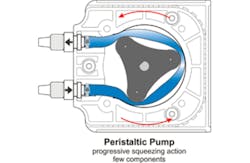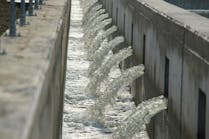Both diaphragm- and peristaltic-type metering pumps (injectors) can provide years of dependable, efficient service. In deciding which to use, it is important to know how each type of pump operates, as well as what sort of regular maintenance is required with each. This will help determine which pump is best suited to your installation.
If you currently use diaphragm pumps in your application, and are having success, you are undoubtedly aware of the importance of basic pump maintenance. The more knowledge you have regarding pump operation and maintenance requirements, the more successfully the pump will perform. Although today’s diaphragm pumps are more sophisticated, including better valve and diaphragm design, material options, improved drive mechanisms and housing, they still require proper operating procedures and regular service for a successful program.
Peristaltic pumps, on the other hand, are initially simpler to use and require less experience to operate; however, they do require an understanding of the installation requirements and regular maintenance procedures.
Diaphragm metering pumps
Pros:
- When properly maintained, a diaphragm metering pump will cost less to operate over time.
- Diaphragm metering pumps are more energy efficient, using more motor torque on the foreword (power) stroke, but far less on the back stroke.
- Overcoming line pressure is easier with a properly sized diaphragm metering pump.
- Less danger of leakage. If poorly maintained, a diaphragm metering pump will lose its prime, but seldom leaks, or damages the area.
Cons:
- The solution being pumped must be clean. Diaphragm metering pumps operate best when the solution being pumped is clean and free from particulates. The reason: Diaphragm metering pumps have check valves in the suction and discharge side of the pump head. If either set of check valves becomes fouled (dirty), the pump will first lose its ability to meter accurately, and finally loss of prime will occur.
- Difficult to prime against pressure. These pumps prime best when there is little to no back pressure. Some pumps are fitted with a bleed valve to aid in this challenge.
- Difficulty priming with dirty check valves. Diaphragm pumps prime best when the valves (check balls) are clean and there is little to no back pressure.
- Difficulty priming when the stroke (feed rate adjustment) is on a low setting. Most diaphragm metering pumps have a diaphragm stroke (feed rate) adjustment, and some also have a motor speed adjustment. Priming is best achieved when the stroke adjustment is above the 60 percent range. These adjustments can be confusing, so it’s best to minimize variables as much as possible. Avoid adjusting the diaphragm stroke length too low, the pump will lose efficiency. Keep your diaphragm stroke above 40 percent if possible; most pumps are simply more efficient with longer stroke lengths.
In summary, a diaphragm metering pump will require the operator to have a good understanding of pump valves, proper priming and adjustment characteristics and their importance. Once there is a good understanding of the pump and it is operating within its normal parameters it will provide dependable and efficient service.
Peristaltic pumps
Pros:
Peristaltic pumps are initially easier to use because they are more forgiving than diaphragm metering pumps.
- Peristaltic pumps work well with high levels of particulate in the solution (un-dissolved solids) being pumped. There are no check balls to foul within the pump tube.
- Feed rates are not affected by either pressure, or the nature of the chemical being pumped.
- Peristaltic pumps prime under maximum back pressure, excellent suction.
- They will not lose prime, they can even pump air.
Cons:
- The constant peristaltic (squeezing) action eventually weakens (degrades) the pump tube and the feed rate is slowly diminished — slightly at first and increasing as the pump tube wears. Modes of failure include: Lack of pressure capability, complete loss of pumping capability, loss of suction lift, reduction in output and tube rupture.
- Squeezing the pump tube requires the drive motor to be under a constant load (similar to a boat motor), using more power.
- If regular service is neglected, the pump tube is not changed or the injection point not serviced, the pump tube may rupture and could damage the pump, or worse. Some manufactures now offer models with sensors that automatically turn off the pump and trigger an alarm in the event of a tube rupture. These new features protect the pump and pump area from damage.
- Tube life expectancy will vary based on many factors, including the output amount, back pressure and the chemical being used. Most manufacturers rate their pumps’ tube life expectancy in hours. Users must be aware of the total number of hours the pump has operated. A common problem with peristaltic pump users is underestimating how many hours the pump has operated.
In summary, peristaltic pumps are excellent at pumping dirty fluids and do not have priming problems; however, they will require regular changing of the pump tube.
Factors affecting both peristaltic and diaphragm metering pumps
- Make certain the pump’s wetted parts are compatible with the chemical being pumped. A diaphragm pump’s diaphragm, pump head, valves, injection fitting and tubing are commonly referred to as the “wetted end.” All of these components require attention. The wetted end on a peristaltic pump includes the pump tube, injection fitting and connection tubing. Be certain these components are compatible with the chemical being pumped. Manufacturers will list the materials that make up wetted parts. The customer must do some research on chemical compatibility. No single material works successfully with all chemicals.
- Read the pump curve. A diaphragm pump’s output will not be the same at atmospheric pressure as it will be at say, 50 psig. As the line pressure increases, the feed rate will decrease. A pump curve will help you, but remember the pump curves provided from the manufacturer are done in a laboratory, pumping pure water. If the solution being pumped has a different viscosity and specific gravity than water, it will affect the pump’s output.
- It’s best to check output by measuring with a graduated measuring cup from suction tubing. In this way, you will learn how the chemical — with the elements considered including viscosity, specific gravity and line pressure — is actually feeding. This is the best way to calibrate the pump.
In summary
Diaphragm pumps excel at pumping clean, aggressive chemicals into high pressure systems with very little maintenance. A variety of wetted parts are available for chemical resistance. However, diaphragm pumps can lose their prime and be difficult to prime, especially if the fluid is dirty or contains trapped gases.
Peristaltic pumps excel at pumping dirty fluids that contain trapped gases or particulate matter into lower pressure systems. Newer peristaltic pump designs are capable of pressures to 100 psig. However, pump tube material options can be limited and, therefore, chemical resistance can be a factor. In addition, peristaltic pumps will require periodic changing of the pump tube.
Research and a good understanding of both the installation requirements and the pump’s operating parameters and maintenance requirements, are vital to choosing the best pump for your application.
Robin Gledhill is the president and CEO of Blue-White Industries. He has been with Blue-White for over 43 years. He has had many years of hands on experience in pump motor assembly, pump assembly and pump testing. Blue-White Industries manufactures CHEM-FEED® and Chem-Pro® diaphragm type, and FLEXFLO® and Flex-Pro® peristaltic type metering pumps, as well as complete metering systems, BW DIGI-METER® digital paddlewheel Flowmeters and a full line of variable area flowmeters. Visit www.blue-white.com for more information.


